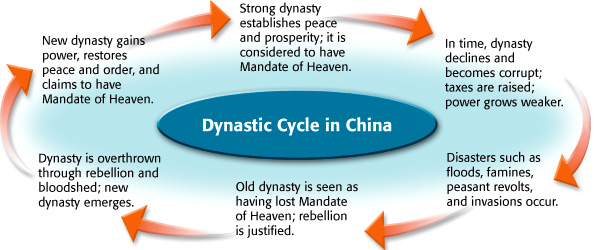Goals and Objectives
By the end of the lesson, students will understand the dynastic cycle and identify specific examples and events of the dynastic cycle in Vietnam. Students will create a concept map that depicts the rise, height and fall of the major Vietnamese dynasties.
Content Standard
7.3 Students analyze the geographic, political, economic, religious, and social structures of the civilizations of China in the Middle Ages.
- Describe the development of the imperial state and the scholar-official class.
Vocabulary
Key terms will be taught within the body of the lesson. Students will include the key terms in the timeline they create. They will define the term, use it in an example and include a representative image. Key terms include:
- dynasty
- invasion
- resistance
- province
- imperial
- missionary
Lesson Introduction
Organization Strategy (Card Sort) - In pairs, students will be given a review sheet on the characteristics of the dynastic cycle (rise, height, fall). Then, using China as an example, they will be asked to sort the cards according to where in the dynastic cycle the events fit (this should be review for them). The teacher will review the activity and discuss what types of events are typical of the rise, height and fall of a dynasty.
Content Delivery
Communication (Reading) Strategies - The teacher will provide readings on the history of Vietnam during the years of autonomous, dynastic rule. These readings can be out of a textbook, trade book, website, or excerpted from a larger book on Vietnam. Students will employ the SOI (Select, Organize, Integrate) approach while reading the information in the text.
SOI Model
Dynasties:
Ngo
Dinh
early Le
Ly
Tran
Ho
late Le
Nguyen
SOI Model
- Select - Students are provided a lens through which they read the informational text (this might be a specific topic, theme, or simply the "big ideas"). Students closely read the assigned passage and select the relevant information. They hold this information in working memory.
- Organize - Students take the selected information and organize it into meaningful chunks. Students actively make connections between ideas, events, people and places and create an organizational scheme. This scheme can be a concept map, timeline, chart, or other organizer.
- Integrate - Students integrate new information into their existing knowledge base. They add to and change their existing schema.
Dynasties:
Ngo
Dinh
early Le
Ly
Tran
Ho
late Le
Nguyen
Student Engagement
Organization Strategy (concept map) - As students read, they will select pertinent information from the text. They will take this information and organize it into a concept map using a mindmapping tool such as mindmeister, mindomo or popplet. The concept map should consist of each of the Vietnamese dynasties and should include events that indicate the rise, height and fall of the dynasty.
Lesson Closure
Communication Strategy - At the end of the lesson, students will revisit the card sort activity they did at the beginning of the lesson. In pairs, they will be given six blank cards and will be asked to write in examples of the rise, height and fall of one of the Vietnamese dynasties and add to the stack of cards. They will trade with another group and re-do the card sort activity.
Assessment
Entry-Level - Students will access and display prior knowledge about the dynastic cycle through the card sort activity.
Formative - Students select pertinent information about the rise, height and fall of the Vietnamese dynasties - the teacher will check student's progress throughout the reading process as students select and record this information.
Summative - Students organize the information they selected from the readings into a timeline recording the rise, height and fall of the Vietnamese dynasties.
Formative - Students select pertinent information about the rise, height and fall of the Vietnamese dynasties - the teacher will check student's progress throughout the reading process as students select and record this information.
Summative - Students organize the information they selected from the readings into a timeline recording the rise, height and fall of the Vietnamese dynasties.
Lesson Resources
Books
SarDesai, D.R. (2005). Vietnam: Past and Present, 4th edition. Cambridge, MA; Westview Press.
Ramsay, J. (2008). Mandarins and Martyrs: The Church and the Nguyen Dynasty in Early Nineteenth-Century Vietnam. Stanford University Press
Websites
Asia for Educators
Asian Nation - Vietnam Early History
Hue Tombs
SarDesai, D.R. (2005). Vietnam: Past and Present, 4th edition. Cambridge, MA; Westview Press.
Ramsay, J. (2008). Mandarins and Martyrs: The Church and the Nguyen Dynasty in Early Nineteenth-Century Vietnam. Stanford University Press
Websites
Asia for Educators
Asian Nation - Vietnam Early History
Hue Tombs

